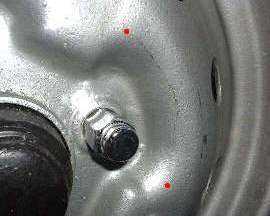The MGA With An Attitude
STRESS CRACKS In Suspension Parts -- FS-204A
 A prerequisite to this course is UT-150, The Nature of Stress Cracks, so read that first.
A prerequisite to this course is UT-150, The Nature of Stress Cracks, so read that first.
The MGA chassis is particularly rugged, so things do not break very often when well maintained. The swivel pins in my MGA are original issue, more than 50 years old with more than a quarter million miles accrued (including a LOT of harsh use) and never a problem. I could say, "Knock on wood", but this implies leaving tomorrow entirely to chance. What I should say is, "It has been a long time since I last inspected my swivel pins, so maybe I should schedule to do it again soon". Most MGA owners have never done this, and the cars are now pushing 50 years old (or more), so for them immediately might be the right time to do it (and the lower A-arm pivots as well). The golden opportunity is any time you might have the front suspension apart for rebuild or maintenance, and especially during a whole car restoration project.
For a daily driver car, suspension crack check once soon after you first take possession of the car, or once during restoration work, may be good until the next time it needs a full restoration, or next time it needs a suspension rebuild. For a hard driving vintage competition car, suspension crack checks may be appropriate semi-annually. For a Pro Rally car perhaps every year or more often. For a professional racing team, maybe before every race weekend.
Some parts may be considered more "fragile", or likely to break more often, and so merit crack checks more often. For instance, MGA steel disc wheels (or wire wheels) are designed to be as light as possible to handle the expected loads. In this case the "expected" loads (back in the day) were significantly less than what we might encounter today. Fifty years ago skinny bias ply tires were the norm, while wider modern radial ply tires have substantially better road grip and WILL apply higher loading on the wheels than the designers ever expected.
To put this in better perspective, design of MGA disc wheels was changed once during production, making the center disk one gauge thicker for more strength, and the rim section one gauge thinner for reduced weight. The later wheels are slightly less prone to cracking, but they still do sometimes using modern tires. The safety factor on these wheels seems to be significantly low (more likely to crack). Also the time between first appearance of a stress crack
 and catastrophic failure may be quite short. Advice then is to visually inspect these parts frequently, and if you see a crack, take the wheel off the car immediately. (Been there). A good time to visually inspect this part is any time you have the hub cap off and a lug wrench in your hand.
and catastrophic failure may be quite short. Advice then is to visually inspect these parts frequently, and if you see a crack, take the wheel off the car immediately. (Been there). A good time to visually inspect this part is any time you have the hub cap off and a lug wrench in your hand.
For wire wheels, SCCA inspection before every event may allow one loose or broken spoke, but you are advised to fix it as soon as possible. Two loose spokes is an instant tech failure (same as any visible crack in a steel wheel).
|